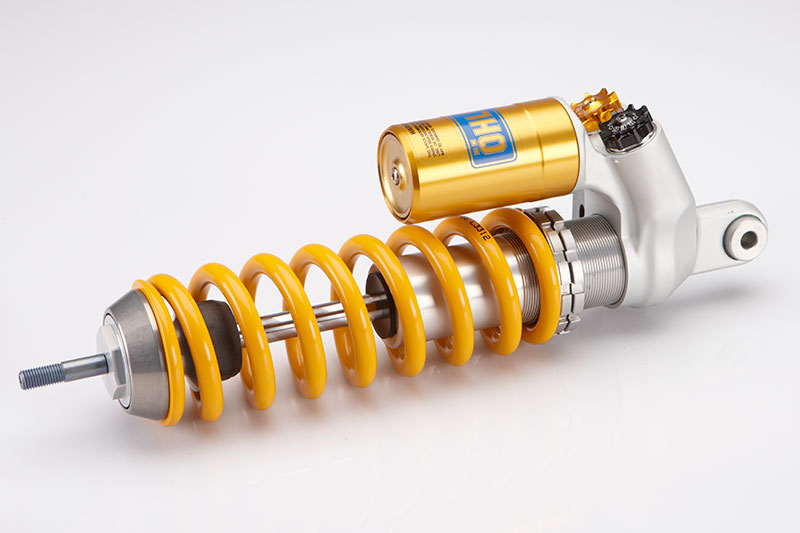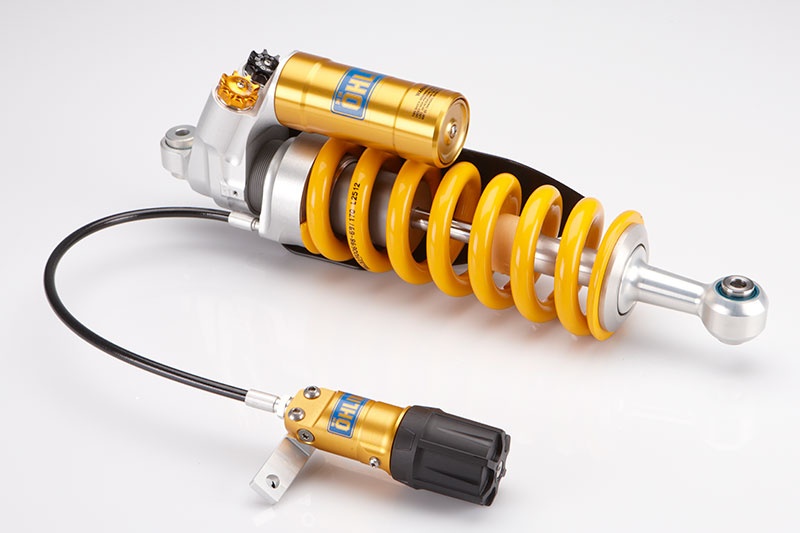
The stock front and rear shocks on the BMW R 1200 perform well most of the time, but their range of adjustment is limited and they can become overwhelmed by heavy loads or extreme riding conditions. Paul Beck, whose 2007 R 1200 GS project bike was featured in our October issue, is bigger (6-foot-4, 300-plus pounds) and rides harder than the typical GS owner. He put 20,000 miles on the stock shocks and another 70,000 on aftermarket shocks from Wilbers before bolting on a set of TTX shocks made by Öhlins.
TTX shocks—“TT” stands for “twin tube”—were developed for automotive and motorcycle racing, and Öhlins has over 100 world championships to its credit. Most shocks with an external reservoir have a single tube—an oil-filled cylinder in which a piston moves back and forth, forcing oil through compression and rebound valves to control damping. As the shock compresses, the piston forces oil into the external reservoir, through the compression valve; when it rebounds, the piston reverses and forces oil through the rebound valve. Low pressure on the suction side of the piston can create air bubbles (cavitation), reducing the damping effect of the oil. Gas pressure in the external reservoir can reduce cavitation, but too much pressure creates stiction.

The patented TTX design uses two concentric tubes, an inner tube with a solid piston and an outer tube that connects the ends of the inner tube, which are fitted with compression and rebound valves. Since oil flows back and forth between the inner and outer tubes, fluid easily fills in behind the suction side of the piston, all but eliminating cavitation. Lower gas pressure can be used, reducing stiction. The result is more consistent damping behavior over the entire stroke of the shock.
Öhlins sent us a TTX36 (36mm piston) for the front and a TTX39 for the rear, both an inch taller than stock (like on GS Adventure models) and with heavy-duty springs matched to bike/rider weight. Installation took a couple of hours. Swapping out the rear shock was straightforward, but to get the front shock in we had to extend the fork completely, which (for the one-inch longer shock) required disconnecting the front brake line and bleeding the brakes afterwards. With the standard length model you can just unbolt the brake line junction from the frame to get the needed slack in the line.
Adjusting spring preload on the front is tricky because the ring and locknut isn’t easily accessible, but adjusting rear preload is easy thanks to a remote adjuster knob that we bolted to the subframe. Separate compression and rebound adjusters are conveniently located at the base of each shock’s reservoir and can be adjusted by hand.
Paul has logged more than 7,000 miles on his GS since installing the Öhlins shocks, including the Oregon Backcountry Discovery Route, a 5-day, 800-mile off-road expedition that put him and his fully loaded bike to the test with everything from gravel roads to 5-mph rock gardens to rutted-out two-track. Like a marksman adjusting for changes in wind speed and direction, Paul obsessively changes settings for road or trail conditions and varying loads. He says the shocks have completely transformed his bike, providing more comfort and instilling more confidence in all conditions.
TTX shocks are available for the BMW R 1200 GS as well as many sportbikes. At $1,005 for the TTX36 front, $1,498 for the TTX39 rear, they’re expensive, but worth it. Keep in mind that shocks that perform this well require rebuilding on occasion—see the website for details. If your GS has Electronic Suspension Adjustment (ESA), a Mechatronic setup is also available.
For more information, call (800) 336-9029 or visit ohlinsusa.com.







